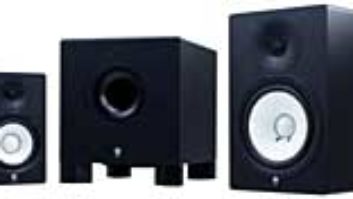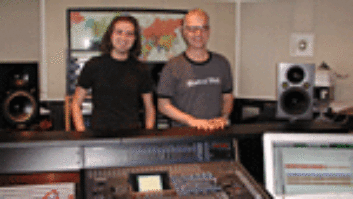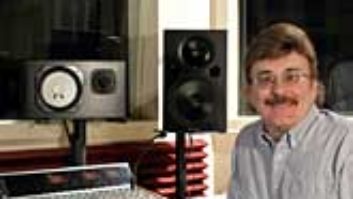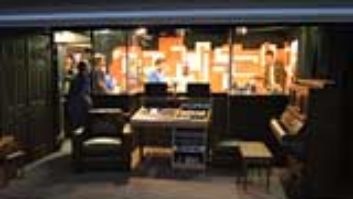BI-AMPLIFIED NEAR-FIELD STUDIO MONITORIntroduced more than 20 years ago, Yamaha’s NS-10M (later upgraded to the NS-10M Studio) is a standard item in thousands of large and small studios worldwide. However, the NS-10M’s popularity stems from the fact that it translates to a “typical” home consumer-style speaker; its performance is less than state-of-the-art. With the introduction of the MSP10, Yamaha has developed a powerful, wideband system that is designed for critical studio listening applications.
THE SYSTEMThe MSP10 is a two-way system, with an 8-inch butyl surround woofer and a 1-inch titanium dome tweeter set in a conical waveguide and housed in a 10.5×16.5×13-inch ported enclosure. The drivers are shielded to reduce picture distortion when the monitors are used near video or computer monitors. Attached along the rear of the cabinet is the amplifier/crossover section, providing 120 watts to the woofer and 60 watts to the tweeter, with a 2kHz crossover point.
The rear panel includes a balanced XLR input connector (pin 2 hot), an input sensitivity adjustment pot, AC switch, and three-position LF and HF switches. The LF control is a fairly gentle 50Hz filter that rolls off the bass with flat, -1.5dB and -3dB settings. The HF control is a 10kHz shelving adjustment with flat, +1.5dB and -1.5dB settings. Also included is a switchable 80Hz highpass filter, which would be employed when the MSP10 is used with an external subwoofer, such as the optional SW10 powered sub ($849 list). The speaker has an attached AC cord. A bi-colored LED set into the face of the tweeter waveguide glows green to indicate power on and flashes red when clipping occurs. Two inset mounting screws on the bottom allow for attaching the MSP10s to optional wall brackets.
Each speaker weighs 44.1 pounds – watch those meter bridges! – so some care in placement is essential. I found that they worked best when used on stands behind the console, at least five feet back from the listening position. The tweeters’ conical waveguides do their job to provide smooth, even dispersion, resulting in a wide listening area. However, their imaging is substantially reduced if the speakers are placed too close together.
IN SESSIONThe four rear panel controls offer ample versatility in adjusting the system to individual needs. The rotary input sensitivity adjustment is wide-ranging, although it lacks steps or a center detent, making exact balancing setup more difficult, unless your system has -10dB outputs and requires the control to be set in the full clockwise position. The MSP10s’ bass sounded fine in my environment, so I left the LF roll-off in the flat position. Even at the flat setting, the speakers have an overly bright sound; the -1.5dB HF shelving took care of that.
The 80Hz highpass setting is ideal for using the MSP10s in a 5.1 situation, and although my listening tests were based on a stereo pair of MSP10s, the wide-dispersion characteristics of these monitors should be well-suited in a multichannel listening environment. The speakers worked equally well when fed from balanced or unbalanced sources.
The MSP10s are capable of delivering solid bass well below 50 Hz (the -10dB down-point is 40 Hz), and with the fairly small diameter of the dual front panel ports, they occasionally hit the listener with blasts of air in high SPL, close-listening situations. It’s another good reason to keep the speakers back a bit and keep levels the same. Maximum rated SPL is 110 dB (1m, on-axis), so levels were never a problem with the MSP10s, and as I usually monitor in the 85 to 90dB range there was ample headroom for dynamic passages.
The MSP10s are priced at $749 each in basic black; but for those who want to make a fashion statement, the MSP10s in a distinctive maple-sunburst finish are $799 each.
Overall, the MSP10s offer a nice balance between lows, mids and highs, with well-damped, natural bass, smooth mids and highs that extend out to 40 kHz (-10 dB). Mixes translated well between the MSP10s and other systems, and the monitors are an excellent choice, either as mains in a project studio/edit suite/multimedia facility or as secondary near-field reference speakers in a larger studio.
Yamaha Professional Audio, 6600 Orangethorpe Ave., Buena Park, CA 90620; 714/522-9011; fax 714/522-9522; www.yamaha.com.




